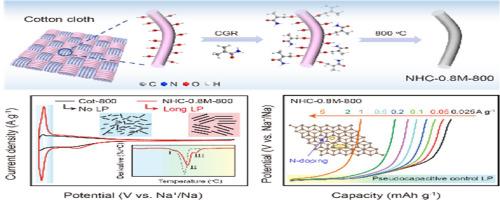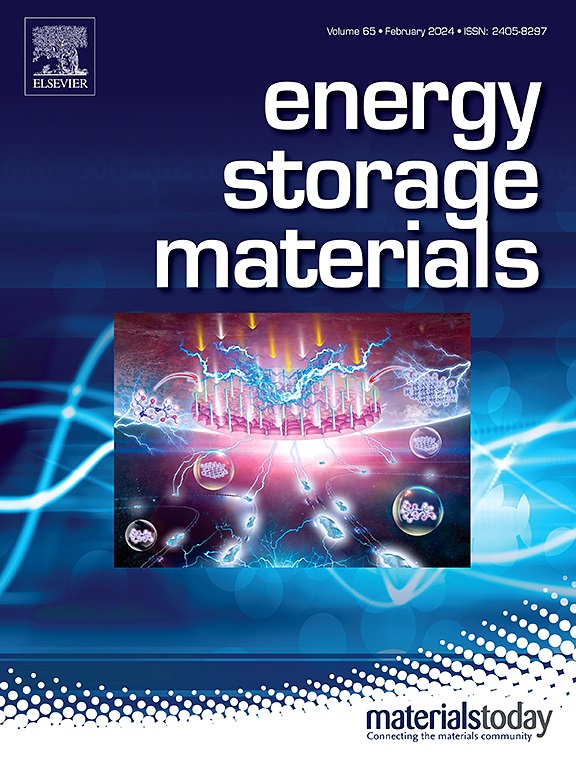Cellulose-grafting boosted pyrolysis nucleation: Achieving low-temperature construction of hard carbon anodes with long low-voltage plateau and ultrafast Na storage kinetics
IF 18.9
1区 材料科学
Q1 CHEMISTRY, PHYSICAL
引用次数: 0
Abstract
Biomass-derived hard carbon (BHC) with low-voltage plateau (LP) is a promising anode material for sodium ion batteries. However, ultrahigh carbonization temperatures to obtain LP and slow electrochemical reaction kinetics in LP make it difficult to achieve low cost and high rate performance. Herein, a cellulose grafting reaction is proposed to modulate the pyrolysis nucleation process of biomass, which makes it possible to obtain a BHC with graphitic nanodomain structure at 800 °C, similar to the hard carbon prepared at the traditional 1300 °C. Moreover, the nitrogen doping introduced by the grafting reaction is highly preserved at low carbonization temperatures, which induces a dramatic shift in the electrochemical reaction kinetics and converts the typical slow diffusion control process in LP to an ultrafast pseudocapacitive control process. As a result, the prepared N-doped BHC simultaneously realizes long pseudocapacitive-control LP, high reversible capacity, excellent rate capability, and ultralong cycle life in sodium ion half/full cell. More significantly, the structure formation mechanism, Na-storage mechanism, and the root causes of electrochemical reaction kinetic shifts in the LP of such a N-doped BHC are studied in detail, which provides a constructive view for the low-temperature construction of BHCs with long LP and high rate performance.


纤维素接枝促进热解成核:实现低温构建具有长低压平台和超快Na储存动力学的硬碳阳极
具有低压平台的生物质硬碳(BHC)是一种很有前途的钠离子电池负极材料。然而,获得LP的超高碳化温度和LP中缓慢的电化学反应动力学使其难以实现低成本和高效率的性能。本文提出通过纤维素接枝反应调节生物质的热解成核过程,使得在800℃下获得石墨纳米结构的BHC成为可能,类似于传统1300℃下制备的硬碳。此外,接枝反应引入的氮掺杂在低碳化温度下得到了高度保存,导致电化学反应动力学发生了巨大变化,将LP中典型的缓慢扩散控制过程转变为超快的伪电容控制过程。结果表明,所制备的n掺杂BHC在钠离子半/全电池中同时实现了长假电容控制LP、高可逆容量、优异的倍率性能和超长循环寿命。更重要的是,详细研究了该n掺杂六六六氯化碳的结构形成机理、na存储机理以及电化学反应动力学变化的根本原因,为低温构建具有长LP和高速率性能的六六六氯化碳提供了建设性的观点。
本文章由计算机程序翻译,如有差异,请以英文原文为准。
求助全文
约1分钟内获得全文
求助全文
来源期刊

Energy Storage Materials
Materials Science-General Materials Science
CiteScore
33.00
自引率
5.90%
发文量
652
审稿时长
27 days
期刊介绍:
Energy Storage Materials is a global interdisciplinary journal dedicated to sharing scientific and technological advancements in materials and devices for advanced energy storage and related energy conversion, such as in metal-O2 batteries. The journal features comprehensive research articles, including full papers and short communications, as well as authoritative feature articles and reviews by leading experts in the field.
Energy Storage Materials covers a wide range of topics, including the synthesis, fabrication, structure, properties, performance, and technological applications of energy storage materials. Additionally, the journal explores strategies, policies, and developments in the field of energy storage materials and devices for sustainable energy.
Published papers are selected based on their scientific and technological significance, their ability to provide valuable new knowledge, and their relevance to the international research community.
 求助内容:
求助内容: 应助结果提醒方式:
应助结果提醒方式:


